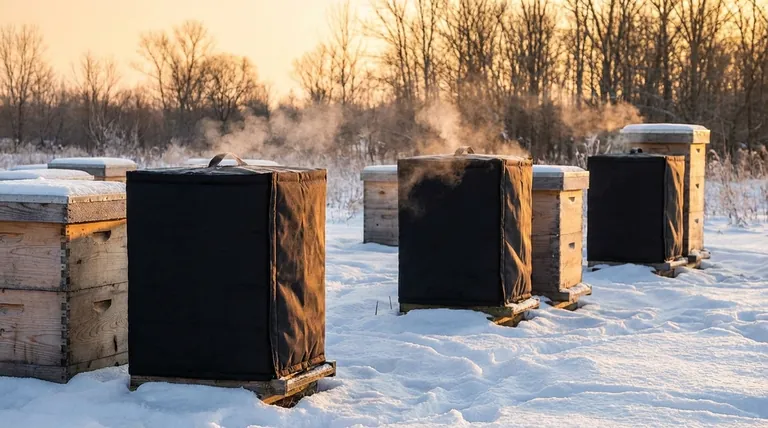The primary benefits of insulated hive covers are superior thermal regulation and critical moisture control. By trapping the heat generated by the bee cluster and preventing condensation, these covers create a stable, dry environment that is essential for a colony's survival, particularly through the winter.
The most critical function of hive insulation is not simply to keep bees warm, but to keep them dry. It prevents the drastic temperature differences that cause lethal condensation to form and drip back down onto the bee cluster.

The Core Functions of Hive Insulation
To understand the value of an insulated cover, we need to look beyond simple warmth and examine the two environmental challenges it solves: temperature fluctuation and internal moisture.
Maintaining Stable Temperatures
A honey bee colony generates its own heat by vibrating flight muscles in a tight cluster. An insulated cover acts like a cap on this system, trapping that precious heat inside the hive.
This thermal regulation reduces the amount of energy the bees must expend to maintain their core temperature. As a result, a well-insulated colony consumes fewer food stores and experiences less stress during the cold months.
Preventing Lethal Condensation
This is the most important benefit of an insulated cover. As the bees respire and generate heat, they release warm, moist air that rises to the top of the hive.
When this warm air hits a cold, uninsulated inner cover, the moisture instantly condenses into water droplets. These cold droplets can drip down onto the cluster, chilling and killing the bees.
An insulated cover keeps the interior surface of the hive top warmer than the dew point, preventing water from condensing in the first place. This ensures the bees remain dry and safe.
Shielding from External Elements
Insulation provides an additional buffer against harsh external conditions. It helps mitigate the effects of wind chill, which can rapidly strip heat from the hive walls.
It also provides an extra layer of protection from environmental moisture like driving rain or melting snow that might otherwise find its way into the hive.
Understanding the Trade-offs
While highly beneficial, implementing insulation requires a holistic understanding of the hive as a system. Simply adding insulation without considering other factors can create new problems.
Ventilation is Still Critical
A common mistake is to insulate a hive so tightly that it cannot breathe. Sealing the hive completely traps the moist air the bees produce, which can lead to mold and other issues.
Effective insulation must be paired with proper ventilation. This is often achieved with a small upper entrance or a dedicated ventilation port, which allows the excess moist air to escape without creating a cold draft.
Insulation Supports, It Doesn't Save
An insulated cover is a powerful tool, but it will not save a weak or failing colony.
A hive going into winter must already be strong, healthy, and have adequate food stores. Insulation helps a healthy colony thrive; it is not a substitute for good beekeeping management.
Making the Right Choice for Your Colony
Deciding to use an insulated cover depends on your climate and your specific goals for hive management.
- If your primary focus is winter survival in a cold climate: An insulated cover is one of the most effective tools for preventing condensation and reducing the colony's winter workload.
- If your primary focus is conserving food stores: By helping the hive retain heat, insulation reduces the amount of honey the bees must consume to stay warm, leaving them with more resources in the spring.
- If your primary focus is creating a stable year-round environment: In climates with dramatic temperature swings, insulation can buffer the hive from both extreme cold and heat, promoting a more consistent internal climate.
Ultimately, using an insulated cover is about creating a stable, dry environment that empowers your bees to thrive through the most challenging seasons.
Summary Table:
| Benefit | Key Function | Outcome for the Colony |
|---|---|---|
| Thermal Regulation | Traps the bee cluster's heat | Reduces energy expenditure, conserves food stores |
| Moisture Control | Prevents condensation from forming | Keeps bees dry, prevents chilling and death |
| Element Protection | Buffers against wind, rain, and snow | Creates a more stable, consistent internal environment |
Equip your apiary for success with HONESTBEE. Our insulated hive covers are designed for commercial beekeepers and distributors who demand durability and performance. Protect your investment, ensure colony health through winter, and maximize honey production. Contact our wholesale team today to discuss your needs and request a quote.
Visual Guide

Related Products
- Professional Insulated Winter Hive Wrap for Beekeeping
- Inner Beehive Cover for Beekeeping Bee Hive Inner Cover
- Professional Galvanized Hive Strap with Secure Locking Buckle for Beekeeping
- Professional Drop-Style Hive Handles for Beekeeping
- Endless Loop Ratchet Hive Strap
People Also Ask
- What is the advantage of an insulated outer cover? Boost Winter Survival & Spring Buildup
- Should bee hives be insulated? Protect Your Colony from Moisture, Not Just Cold
- Why is insulation important for hives during winter? Ensure Your Bees Survive and Thrive
- What factors ensure bees stay warm and healthy during winter? Master the 3 Keys to Hive Survival
- Is it always necessary to insulate beehives? A Guide to Winter Survival & Colony Health



















